Improve your Marketing Ops every week
Subscribe to our blog to get insights sent directly to your inbox.
Confront your process problems head on with a Sherpa by your side.
Explore support options that are tailored to meet you wherever you are on your climb.
Browse our pioneering Agile marketing courses
Learn from the stories of marketers already on the road to process improvement.
Featured Resource

State of Agile Marketing
Learn from 8 years of study on how marketers are increasing their agility.
Download Report
Everyone who takes the responsibility of leading people does it in their own way. The problem is, not all leadership styles are suited to supporting an Agile team.
As the global trend of transitioning from traditional to Agile management continues, a growing number of marketing managers and directors ask themselves what the best approach to leading an Agile organization is.
For better or worse, there’s no such thing as one ultimate way to lead Agile teams effectively. To be successful in such a role, leaders need to be flexible and ready to change their approach based on the situation at hand.
The good news is, there are proven leadership styles that managers and directors can use to adapt to different contexts. In this article, we’ll explore six approaches to leading teams. All of them are worth experimenting with and we will provide examples of situations where they would prove useful when working in an Agile environment. We are also going to give you the key to unlocking their power. Let’s dive in.
There are six adaptive leadership styles defined by the internationally known psychologist Daniel Goleman that are suitable for managing Agile organizations. Their usefulness depends on the team and situation. The above-mentioned styles are:

Each adaptive leadership style requires unique behaviors from the person applying it.
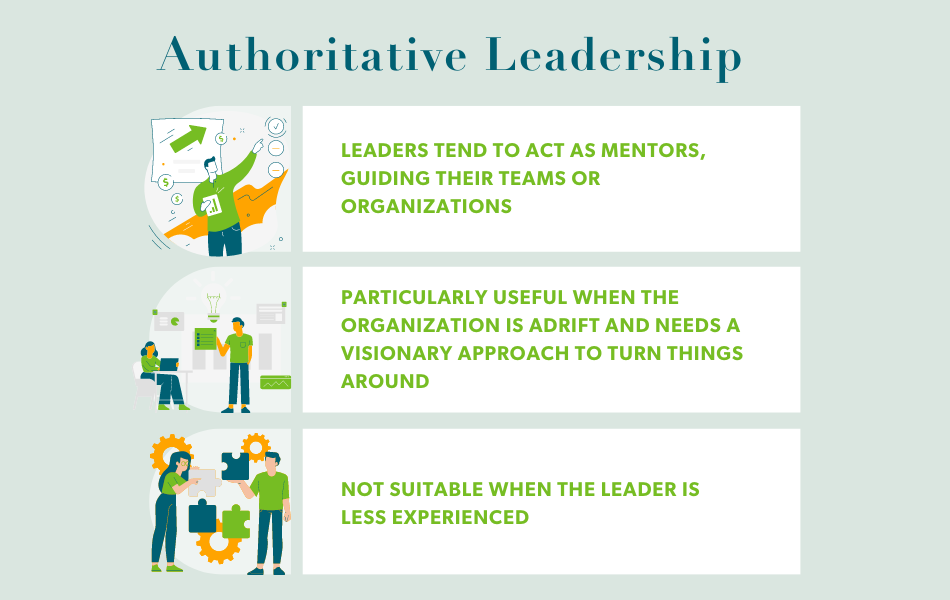
The authoritative leadership style was initially defined by Daniel Goleman back in 2002. People who apply this leadership approach tend to act as mentors, guiding their teams or organizations. Authoritative leaders mobilize their team members by creating and sustaining clarity and commitment to the organization’s goals and strategy.
This adaptive leadership style requires a firm understanding of the challenges to overcome, the goals we strive to reach, and a clear vision for achieving success. However, when applying it, we must give our teams flexibility to devise means for reaching the predefined goals.
The authoritative leadership style works well in almost any context but is particularly useful when the organization is adrift and needs a visionary approach to turn things around.
On the other hand, this adaptive leadership style is not suitable when the leader is less experienced than the team because the proposed vision is likely to face resistance from within. In addition, the authoritative way is very likely to be ineffective if the leader becomes overbearing and undermines the egalitarian Agile spirit.
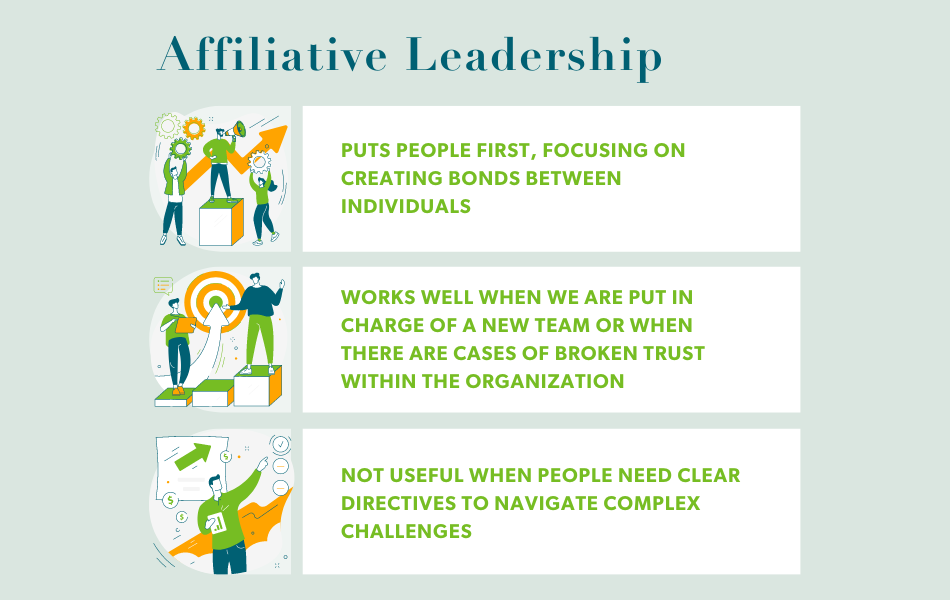
The affiliative leadership style puts people first, focusing on creating bonds between individuals. For leaders that prefer it, individuals and emotions are more meaningful than tasks and goals.
The great thing about this adaptive leadership style is that it builds a sense of belonging, which is crucial for sustaining high performance in the long run. When applying it, we experience great harmony within the team or organization, observe high employee morale, trust between colleagues, and seamless communication.
The affiliative leadership style works well when we are put in charge of a new team or when there are cases of broken trust within the organization. However, it might prove to be insufficient for effective management in the long run if we apply it as the sole leadership approach. This is why we recommend using it in symbiosis with the other adaptive leadership styles covered in the article. The affiliative approach works especially well when we apply it together with authoritative leadership.
Like any style of leading people, the affiliative one has a downside. Although it’s great for building bonds and relationships, this approach is not useful when people need clear directives to navigate complex challenges. This is mostly due to the “people come first” principle that drives it, which in some situations needs to be neglected for the good of the organization (e.g. during an attempt for a hostile takeover).
Like the governance system from which it is derived, the democratic leadership style is based on the desire to build consensus within a team or organization.
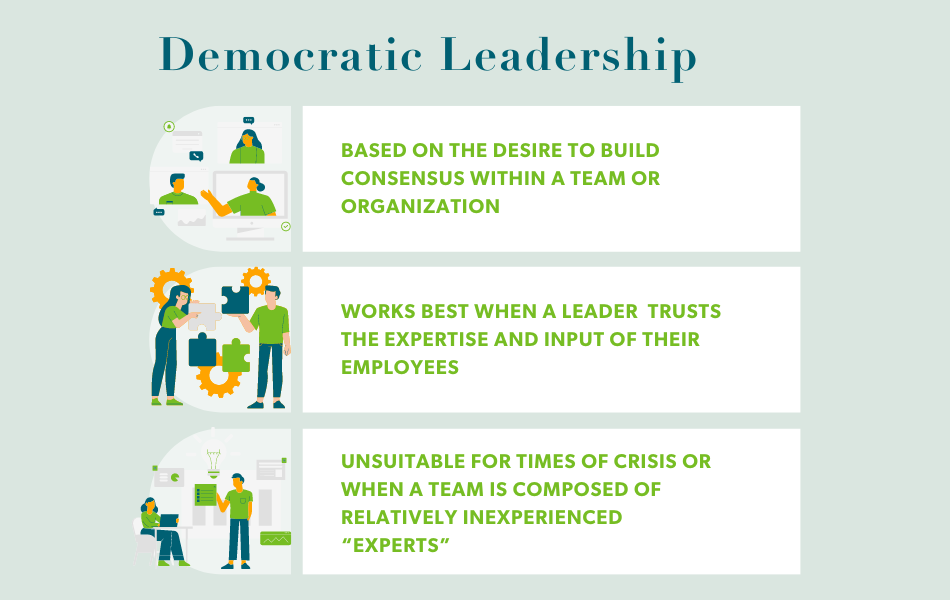
It involves a lot of listening and discussion to collect employees’ ideas and buy in. The great thing about this adaptive leadership style is that it gives voice to individual contributors, which in turn creates trust, respect, and commitment within the organization.
Democratic leaders are usually well aware of the necessary behaviors for keeping morale high and inspiring a sense of ownership within their teams. Since everyone has a say, expectations within such organizations tend to be more realistic and accepted by employees.
The democratic leadership style works best when a leader is uncertain about the best direction and trusts the expertise and input of their employees. However, this approach comes with the risk of creating a feeling of confusion and leaderlessness if even the smallest decisions are brought up for discussion.
The biggest downside of this adaptive leadership style is that it may hinder productivity by engaging in endless meetings to achieve the consensus it treasures so much. The approach is especially unsuitable for times of crisis when there’s a need for quick and decisive decision-making or when a team is composed of relatively inexperienced “experts” that are not competent or informed enough to make decisions.
Pacesetting is among the most demanding leadership styles suitable for Agile management. It relies on setting high expectations for employees and relentlessly pushing toward achieving excellence.
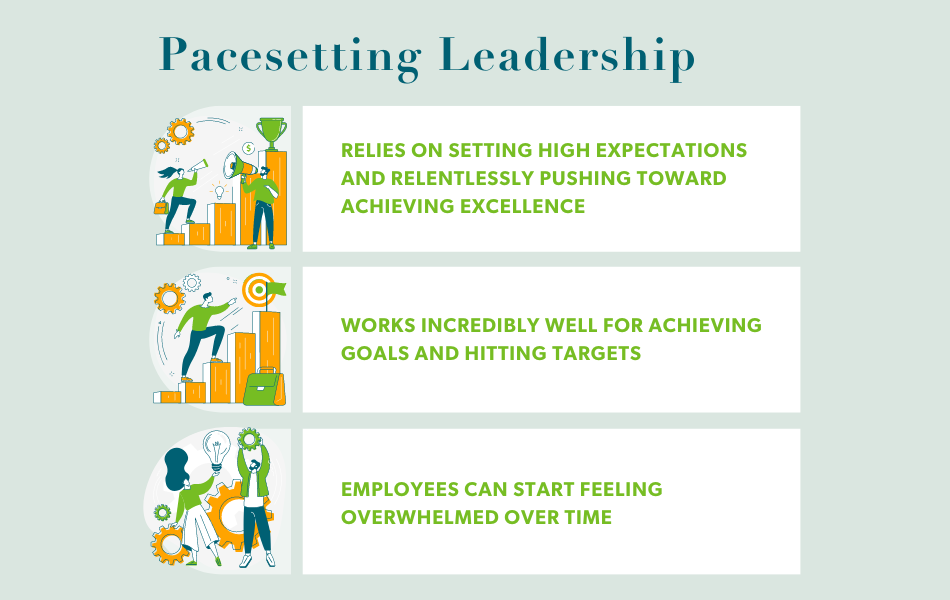
Leaders who practice this approach tend to be obsessive about continuous improvement. They quickly reveal poor performers within the organization and demand improvement or changes in personnel.
The great thing about this adaptive leadership style is that it works incredibly well for achieving goals and hitting targets when a team is highly competent and motivated.
However, there are a few major downsides that make it dangerous to use for prolonged periods of time. The biggest one is that employees can start feeling overwhelmed over time, especially if there are no clear guidelines from the leader.
In addition, work tends to become task-focused and routinized, which has a negative effect on innovation. This is mostly due to the constant push for a better pace and little incentive to try new ways of doing things. Last but not least, pacesetting leadership may hinder the team’s spirit as it creates an environment of never-ending urgency and possibly, overburden.
Like the other leadership styles mentioned in this article, pacesetting leadership should never be used as a sole leadership style. However, if applied together with coaching leadership, for example, it might bring enormous value to an Agile marketing team.

The coaching leadership style is focused on developing people for the future. Managers and directors who apply it put heavy emphasis on helping employees to identify their unique strengths and weaknesses, then tie them to personal and professional aspirations.
Leaders who rely on the coaching leadership style are very open to delegating even the most complex assignments and challenge their teams to facilitate growth even at the expense of speed and efficiency.
Although it’s the least commonly used, the approach has a huge positive impact on the organizational climate due to the high engagement of the leader with each team member they support. When applying it, we have to focus on dialogue and constantly clarify expectations to facilitate continuous improvement.
This adaptive leadership style works best when employees are open-minded and understand how new skills will help them advance their careers. On the other hand, coaching leadership may prove to be ineffective when managing groups of senior team members who are reluctant to try new things and build new skills.
As a downside, the approach is very difficult to apply in high-pressure environments where there’s little room for experimentation and mistakes have a high cost for the organization.
Coercive is the last adaptive leadership style on our list. It focuses on facilitating compliance by employees as the manager/director expects them to strictly follow instructions.
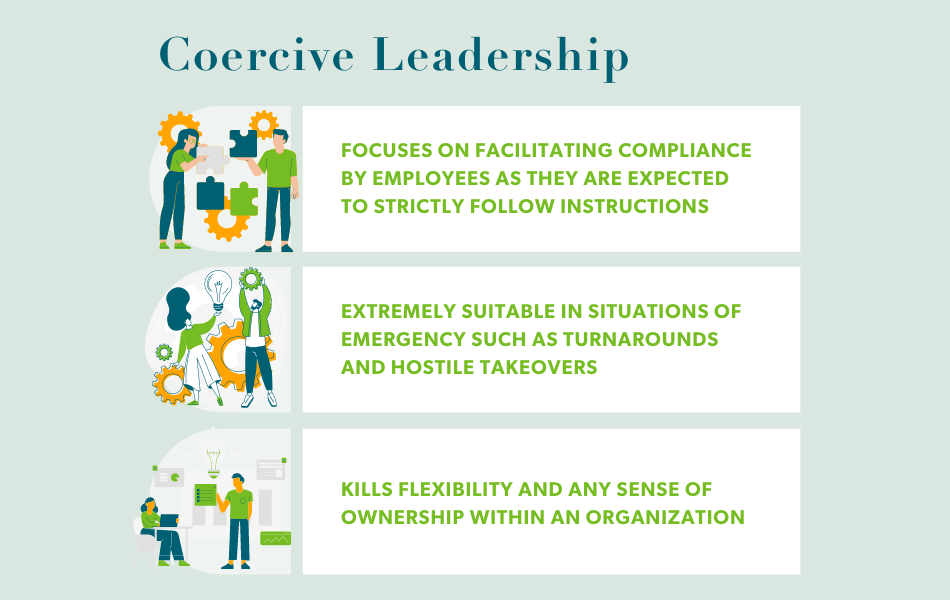
It is the least effective approach to managing Agile teams due to several major downsides that we are going to showcase in the next paragraphs. However, it has value in some situations, so we can’t just pass it by.
Coercive leadership is extremely suitable in situations of genuine emergency such as turnarounds and hostile takeovers when there’s no time for debate, experimentation, or putting people’s feelings first. In addition, this leadership style may be used as a last resort when dealing with problematic inter-team situations after every other approach has failed.
The list of downsides is long when it comes to this adaptive leadership style. First and foremost, it kills flexibility and any sense of ownership within an organization.
Coercive leadership also has an eroding effect on employee morale and in many cases destroys any pride in the work that employees do. Last but not least, this leadership style does very little for facilitating a sense of shared purpose, which is key for high-performing teams.
We advise using coercive leadership with extreme caution and only when absolutely necessary.
Before proceeding to learn what the the key to adaptive leadership is, why don't you take a second to get the recording of our webinar "Helping Leaders Overcome Barriers Towards Leadership Agility"?
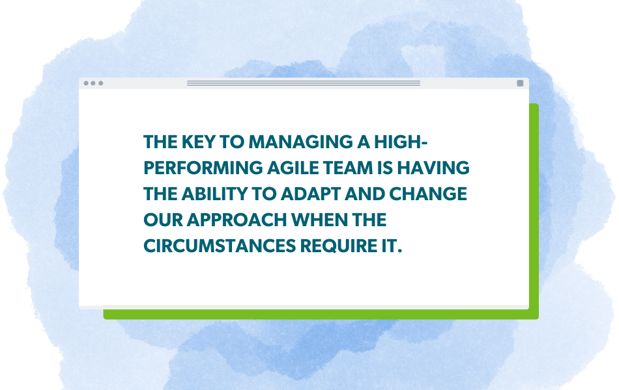
Every leadership style has its pros and cons. To be a successful leader in an Agile environment, we benefit from changing our approach based on the situation at hand. This adaptability is not easy given each leader’s natural preference for specific leadership styles that may have even been at the foundation of their successful careers.
However, the key to managing a high-performing Agile team is having the ability to adapt and change our approach when the circumstances require it.
This wouldn’t be possible without having great situational and self-awareness because we wouldn’t know when the best time to change our leadership approach is or how our behavior affects the people we lead. So far in the article, we’ve covered the situations in which one leadership style or another would serve us best.
However, without understanding self-awareness, we will have a difficult time unlocking their full power and succeeding in Agile leadership. According to Daniel Goleman, self-awareness means having a deep understanding of our emotions, strengths, weaknesses, needs, and drives as people and as leaders.
Having a great sense of self-awareness prevents us from engaging in toxic behaviors that diminish the value of any given leadership style and protect the team from experiencing downsides associated with each approach.
Working in an Agile environment and leading teams and organizations that embrace the accompanying values and principles requires flexibility. As leaders, we can’t be flexible without the ability to adapt our behavior to the circumstances that we face.
Luckily, there isn’t one single best approach to leading with agility, there are six adaptive leadership styles that work better or worse depending on the circumstances.
These leadership styles can also be used in combination. Good pairs include authoritative and affiliative leadership as well as pacesetting and coaching. Experimenting with different combinations might bring us surprisingly good results as well, so the important thing is to stay agile and self-aware. Also remember that if you're wondering how to understand your own leadership style or how your approach to leadership should evolve, Agile marketing coaching can help.
If you’re leading teams and want a deep dive into effective Agile leadership, check out our award-winning certification program on the topic.
Subscribe to our blog to get insights sent directly to your inbox.
Subscribe to our blog to get insights sent directly to your inbox.